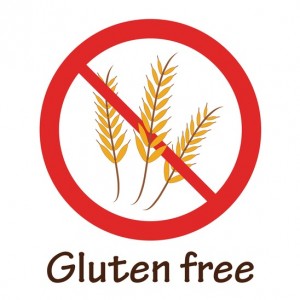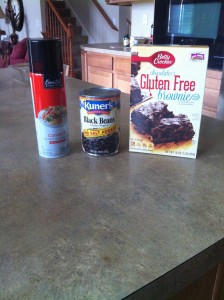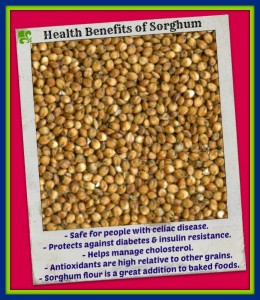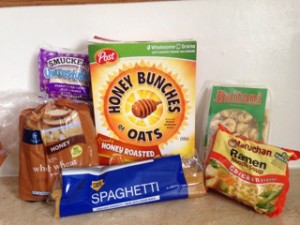Sticking to a gluten-free diet is a challenge under the best of circumstances but when it comes to creating desserts things get even more difficult. So many delicious desserts like pies, cookies, cakes and pastries are made with flour containing gluten.
Creating delicious gluten-free desserts becomes easier when you keep the right ingredients on hand. Some common items to keep in your pantry include:
Almond meal flour
Arrowroot powder
Baking powder
Bittersweet chocolate
Canola oil
Cashew butter
Cocoa powder
Coconut flakes
Coconut milk
Cornstarch
Dried fruit
Espresso powder
Evaporated milk
Gluten-free flour mixes
Gluten-free spices
Granulated, powered and brown sugar
Lemon extract
Maple syrup
Nuts
Peanut butter
Rice
Seeds
Shortening
Sorghum flour
Tapico starch/flour
Vanilla extract
Be sure to check the ingredients on these products before you purchase them. You will want to avoid wheat, barley, brown rice syrup, caramel coloring, rye, brewer’s yeast, wheat starch, hydrolyzed wheat protein, malt, malt extract, malt syrup, dextrins and malt flavoring.
Remember that baking gluten-free is different than regular baking. If you don’t use a baking mix you will need to combine gluten-free flours to get the right results. You can use psyllium husks, ground chia seeds or flaxseed rather than xanthan gum if it gives you stomach distress. Baking at a lower temperature is recommended for some recipes to keep your dessert from getting too brown. If you screw up a recipe consider turning it into crumbs for toppings or to be added to other recipes.
Many gluten-free flours don’t contain preservatives so you may find that desserts made with them dry out quickly or become rancid. Store these items in a zip-top bag (with air removed), freezer wrap or in an air tight container in the refrigerator or freezer separated from other food. Mark all containers used for gluten-free food to keep them separate from other containers. Bring the stored food to room temperature before consuming.
Our favorite gluten-free dessert recipe courtesy of http://bakedbree.com.
Gluten Free Blueberry Crisp
Ingredients:
4 cups blueberries (any fruit will work)
Crisp:
1 cup gluten free old-fashioned, gluten free oats (we used Bob’s Red Mill GF oats)
1/2 cup chopped raw pecans
1/2 cup almond meal
1/4 cup olive oil
1/4 cup pure maple syrup
1/2 teaspoon salt
1. Wash and pick over the blueberries. Add to an 8×8 pan. Add oats, pecans, almond meal, olive oil, maple syrup, and salt to a small bowl. Mix to combine.
2. Spread the mixture over the blueberries.
3. Bake in a preheated 350 degree oven for 35 to 40 minutes, longer if the berries are frozen.
© 2015, Gretchen Scalpi. All rights reserved. You are free to reprint/republish this article as long as the article and byline are kept intact and all links are made live.
Gretchen Scalpi is a Registered Dietitian, Certified Diabetes Educator and Certified Wellcoach®. She is the author of “The EVERYTHING Guide to Managing and Reversing Pre-Diabetes 2nd Ed.”, “The EVERYTHING Diabetes Cookbook 2nd Ed.”, “Pre-Diabetes: Your Second Chance At Health”, “The Quick Start Guide to Healthy Eating”, “The Quick Start Guide To Pre-Diabetes” and “Quick Start Recipes For Healthy Meals”.
 There is something about autumn. Even in California the weather cools and mellows. Fall foliage turns orange, red and yellow. Starbucks starts selling their pumpkin and chestnut lattes. Halloween beckons and the holiday season is right around the corner.
There is something about autumn. Even in California the weather cools and mellows. Fall foliage turns orange, red and yellow. Starbucks starts selling their pumpkin and chestnut lattes. Halloween beckons and the holiday season is right around the corner.




 Wheat, flour, barley, and rye. Those who are gluten free know these are the basic ingredients that contain the protein, gluten, in breads, cereals, pastas, desserts and processed foods today. However, even the most unexpected foods and non-food items can contain traces of gluten from tea to envelopes! Read on to learn about hidden gluten.
Wheat, flour, barley, and rye. Those who are gluten free know these are the basic ingredients that contain the protein, gluten, in breads, cereals, pastas, desserts and processed foods today. However, even the most unexpected foods and non-food items can contain traces of gluten from tea to envelopes! Read on to learn about hidden gluten.